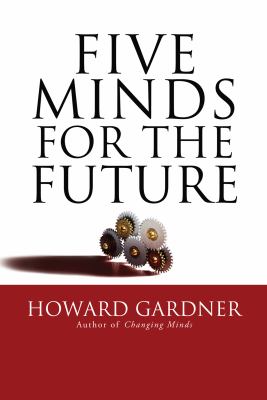Five minds of the future by Robert Gardner
About the book
Author: Gardner, Howard. Title: Five minds for the future. Publication: Boston, Mass. : Harvard Business School Press, c2007. ISBN 9781591399124.
196 pages in the paper edition; 6hrs., 15 mins. as a recorded book.
About the story
American developmental psychologist Howard Gardner, Hobbs Professor of Cognition and Education at the Harvard Graduate School of Education, wrote this book to describe the intellectual skills and the type of learning he thinks will be necessary to succeed in the workplace of the future.
He proposes five “minds”, or domains of learning, that educators, employers and individuals must foster:
- The disciplined mind
- The synthesising mind
- The creative mind
- The respectful mind
- The ethical mind
By disciplined mind, he means someone who has an in-depth knowledge of her or his domain or profession (at least 10 years), and a grasp of the fundamentals of science, math, history and of other intellectual pursuits. He sees this starting at a young age, after the mastery of the basic literacies in school, and continuing to develop and deepen throughout life. He also discusses interdisciplinary learning, where mastery in more than one domain is acquired, and where the two or more domains inform the decisions and practice of the individual.
The disciplined mind, he explains, is a pre-requisite for the synthesising mind, a mind which can take in and organise the massive amounts of information we are faced with and then explain it in such a way that others can understand it. Synthesising ability develops from early attempts to explain what has been taught, through literature or field-of-study reviews at school or in the workplace, and ideally leading to sophisticated gathering and condensing of information in both personal and professional life. The synthesising mind understands the details but focuses on and explains the bigger picture as a whole. He distinguishes this ability from that of the creative mind, which takes the mastery of existing concepts and extends them to uncover a new concept, create a novel product or devise an effective solution. Before it can be creative, he tells us, the mind must be both disciplined and be able to synthesise. He imagines these three minds as interconnected, building upon each other.
Next, the respectful mind, approaches different people, perspectives and cultures with more than just curiosity or tolerance, but with genuine respect. This, he posits, is necessary for our very survival, and will become increasingly important as communication between different counties and cultures becomes faster and easier. He intends the term to cover inter-racial and inter-cultural relationships, as well as relationships among people from the same society or organisation who occupy different positions in the hierarchy: respect for one’s superiors and inferiors, as well as for one’s peers and neighbours.
Finally, the ethical mind is possessed by one who understands her or his responsibilities—both as a member of a profession and as a member of society—and who strives to fulfill them. Being ethical involves understanding what it right and using those principles guide your actions and decisions, rather than letting things like personal gain or pride derail you from the ethical path.
Gardner clearly explains the reasons he considers each of these cognitive abilities to be essential, and illustrates each section with both positive and negative examples of the qualities he describes.
This book, which originally appeared in 2007, is largely based on his previous work, Frames of Mind: The Theory of Multiple Intelligences (1983). He goes on to explore some of the “minds” in greater depth in later publications.
I thought the book was well-written and engaging, though perhaps a bit prescriptive. It was clearly written to help teachers guide “future leaders” into specific habits of mind, and to instruct employers on what to look for in future employees (or to remediate in existing ones). The book was well-structured, following the time-honoured “say it, explain it, say it again” formula that is so essential for learning and teaching.
Overall, his approach provides a useful perspective for someone who is either teaching others or continuing their own education, because it breaks down professional learning and behaviour into novel categories and encourages readers to think about their own practice in relation to them.
Recommended?
Interesting. Not earth-shattering.
